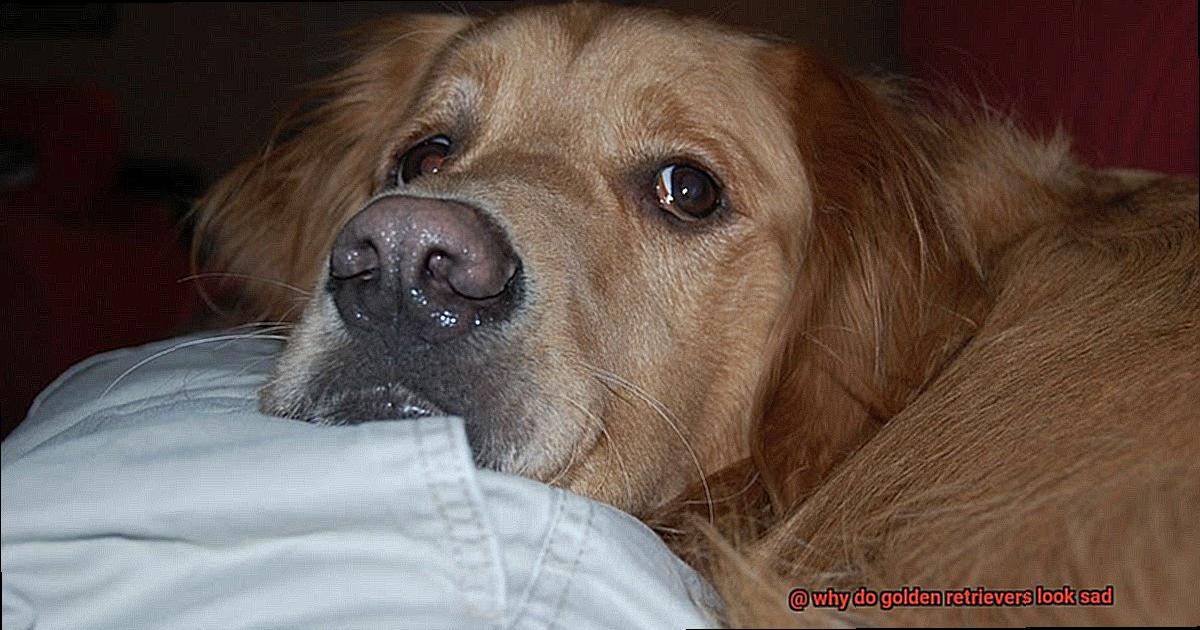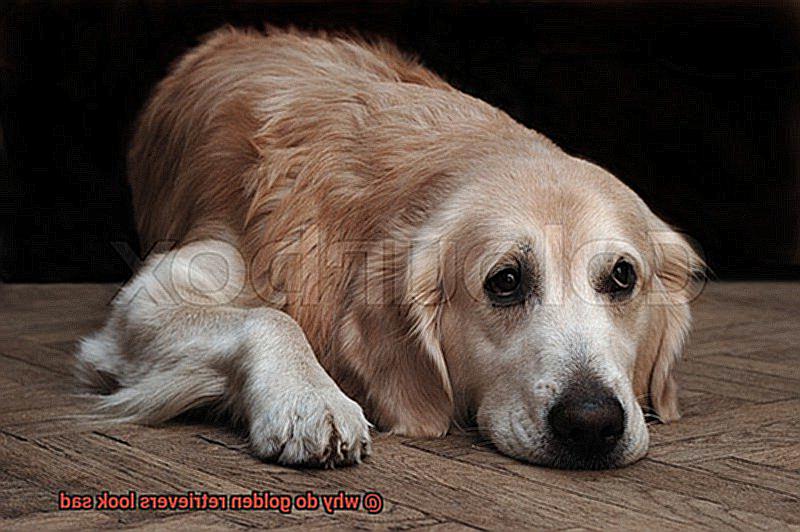Golden Retrievers are a breed that can melt anyone’s heart with their luscious golden fur, floppy ears, and big eyes. But have you ever noticed their sad expression? It’s hard to resist asking yourself, why do Golden Retrievers look sad?
Interestingly, the answer to this question has an evolutionary explanation. Golden Retrievers were selectively bred for their friendly behavior and loyalty towards their owners. Originally trained as hunting dogs to retrieve birds without damaging them, their sad expression is a result of years of breeding that has given them an innocent and vulnerable look.
But there’s more to it than just selective breeding. Golden Retrievers are also sensitive beings who pick up on their owner’s emotions. Their loyalty makes them empathetic towards their owner’s moods, which can reflect in their expressions. So if you’re feeling down, your furry companion may appear sad too.

However, don’t let the sad expression fool you into thinking they are unhappy. These dogs have a loving disposition and are incredibly resilient, making them popular pets for families worldwide.
In conclusion, while the sad expression in Golden Retrievers may tug at our heartstrings, it is not an indication of unhappiness or depression. Instead, it is a result of selective breeding for traits like loyalty and sensitivity towards human emotions. So next time you see a Golden Retriever with a sad face, remember that behind those big brown eyes lies one of the happiest and most loving breeds out there.
Facial Structure of Golden Retrievers
Contents
Golden Retrievers are one of the most beloved dog breeds around the world, and it’s no wonder why. They are known for their friendly and affectionate nature, their loyalty to their owners, and their love of play. However, there is one thing about them that tends to perplex many people: their facial structure.
Golden Retrievers have a unique facial structure that can make them appear sad or mournful even when they are feeling happy and content. One reason for this is their droopy eyes and slightly downturned mouth. The skin around their eyes is loose, which creates a slight droop in their eyelids. Additionally, their eyebrows are often raised, giving the impression of a furrowed brow and contributing to the sad expression.
The position of their mouth also plays a significant role in their facial expression. Golden Retrievers have a slight downturn at the corners of their mouths, which can make them look like they are frowning. This is because the muscles that control the corners of their mouths are relaxed, which gives them a more relaxed expression overall.
However, it’s important to remember that not all Golden Retrievers look sad all the time. Each dog has its own unique personality and ways of expressing itself, and some may have a more cheerful or energetic demeanor than others. Plus, just like humans, dogs can have off-days or feel under the weather.
It’s also essential to pay attention to other signs of your dog’s well-being, such as their body language and behavior, rather than solely relying on their facial expressions to gauge their emotional state. And while Golden Retrievers may sometimes look sad, they are known for being joyful and loving dogs who crave attention and affection from their owners.

Temperament of Golden Retrievers

Golden Retrievers are the epitome of a friendly and outgoing dog breed, beloved by millions worldwide. However, some pet owners may notice that their Golden Retriever appears sad or depressed at times. As an expert in the temperament of Golden Retrievers, I am here to provide you with a comprehensive understanding of this behavior and how to address it.
Firstly, it is important to note that Golden Retrievers are highly social animals that require plenty of attention and interaction with their owners. If they do not receive enough stimulation or activity, they may become bored or anxious, leading to a sad or depressed appearance.
Furthermore, Golden Retrievers are incredibly sensitive to their owner’s emotions. They have an unbreakable bond with their humans and can quickly pick up on their emotional state. If their owner is feeling down or stressed, the dog may also display symptoms of sadness or depression.
It is crucial to keep in mind that dogs do not experience emotions in the same way humans do. While some Golden Retrievers may appear sad or depressed, it doesn’t necessarily mean they are experiencing those emotions. Instead, they may be displaying certain behaviors for other reasons.
To prevent boredom and anxiety in your Golden Retriever, providing plenty of stimulation and attention is vital. This can include daily walks or playtime, training sessions, and interactive toys. Additionally, it’s essential to be aware of your emotional state and how it may affect your furry companion.
Not All Golden Retrievers Look Sad All the Time
While their droopy eyes and eyebrows can create a melancholic appearance, it’s not necessarily an accurate reflection of their emotional state. Golden Retrievers are renowned for their happy-go-lucky nature and friendly demeanor.
The shape of a Golden Retriever’s eyes and eyebrows can contribute to their perceived sadness, even when they’re feeling content. Additionally, their soft, floppy ears can enhance this appearance. However, don’t be fooled by their expression. These furry friends are incredibly intuitive and can pick up on their owner’s emotions. They may mirror your feelings with their own expressions, so be mindful of your mood around them.
That said, there are times when a Golden Retriever may actually be feeling down. Illness, loneliness, or boredom can all have an impact on their emotional well-being. As an owner, it’s essential to pay attention to your dog’s behavior and mood and provide them with the necessary care and attention they need to thrive.
Ways to Help Your Dog Express Positive Emotions
There may be times when you notice your dog looking sad or down, which can be concerning. Fortunately, there are many ways to help your Golden Retriever express positive emotions and live their best life. Here are five ways to ensure that your furry friend is always happy and content:
Exercise and playtime
Golden Retrievers are highly active dogs that require plenty of physical activity to stay healthy and happy. Taking your dog for daily walks or playing fetch in the backyard can help them release any pent-up energy and stimulate their mind. This not only helps keep your dog physically fit but also promotes a happier outlook on life.
Positive reinforcement training
Positive reinforcement training involves rewarding your Golden Retriever with treats or praise when they exhibit good behavior or perform a desired action. By using positive reinforcement, you can encourage your dog to behave in a way that brings them joy and happiness. This will also help strengthen the bond between you and your furry friend.
Quality time spent together
Spending quality time with your Golden Retriever is crucial for their emotional well-being. Whether it’s cuddling on the couch or going for a car ride together, spending time with your dog can create a sense of security and comfort for them. It also helps strengthen the bond between you and your furry friend.
Toys and puzzles
Providing your Golden Retriever with toys and puzzles can help keep them entertained and mentally stimulated. Toys not only provide mental stimulation but also give them something to focus their energy on. Puzzles, such as treat dispensers or hide-and-seek toys, can also challenge their minds and keep them entertained.
Healthy diet
A balanced diet that includes all the necessary nutrients can help improve your Golden Retriever’s overall health and well-being, which in turn can lead to a happier dog. Additionally, providing your dog with treats as rewards for good behavior or during training sessions can also help boost their mood.
Signs of Your Dog’s Well-Being
Sometimes, it can be hard to tell if your dog is feeling their best. That’s why it’s important to know the signs of your dog’s well-being.
First and foremost, a dog’s physical appearance is a strong indicator of their overall health. A shiny coat, bright eyes, clean ears, good muscle tone, and healthy weight are all signs of a happy and healthy pup. If you notice any changes in your dog’s appearance, such as dull fur or weight loss, it could be a sign that something is off.
Behavior is another key indicator of your dog’s well-being. A happy and healthy dog will be active, alert, and playful. They will love spending time with their human family and will seek out attention and affection. If your furry friend seems lethargic, disinterested in activities they used to enjoy, or isolates themselves from others, it might be time to check in with your vet.
Your dog’s eating habits are also a crucial element of their overall health. A healthy dog will have a good appetite and will eagerly eat their meals. If your dog suddenly loses interest in food or refuses to eat altogether, it could be a sign of an underlying health problem.
Regular veterinary check-ups are essential for ensuring your dog’s well-being. These appointments can help detect health issues early on before they become more serious problems. Your vet can also provide advice on nutrition and exercise to keep your furry friend healthy and happy.
Conclusion
Golden Retrievers are undoubtedly one of the most endearing dog breeds, with their friendly and loving nature. However, their droopy eyes and slightly downturned mouth can often create a sad or mournful appearance that leaves many people wondering why. Well, the answer lies in their evolutionary history.
Golden Retrievers were selectively bred for their loyalty towards their owners, resulting in an innocent and vulnerable look that tugs at our heartstrings. Moreover, these sensitive creatures tend to reflect their owner’s emotions in their expressions, making them appear even more melancholic at times.
But before you jump to conclusions about your Golden Retriever’s emotional state based solely on their facial expression, it’s essential to pay attention to other signs of well-being such as body language and behavior.
While some Golden Retrievers may appear sad or depressed at times, it doesn’t necessarily mean they are experiencing those emotions. Instead, they may be displaying certain behaviors for other reasons like boredom or anxiety.
To ensure that your furry friend is always happy and content, providing plenty of stimulation and attention is vital. Regular exercise and playtime, positive reinforcement training, quality time spent together, toys and puzzles, and a healthy diet can all help keep your Golden Retriever emotionally fulfilled.
In conclusion, while the sad expression in Golden Retrievers may tug at our heartstrings, it’s crucial to remember that it does not necessarily indicate unhappiness or depression. These dogs have an inherently loving disposition and are incredibly resilient pets for families worldwide.









